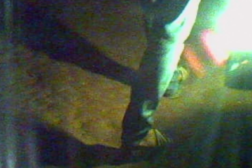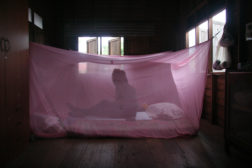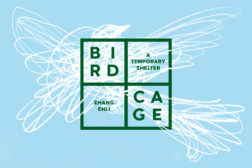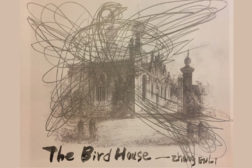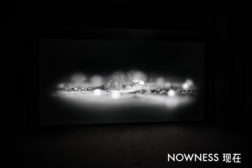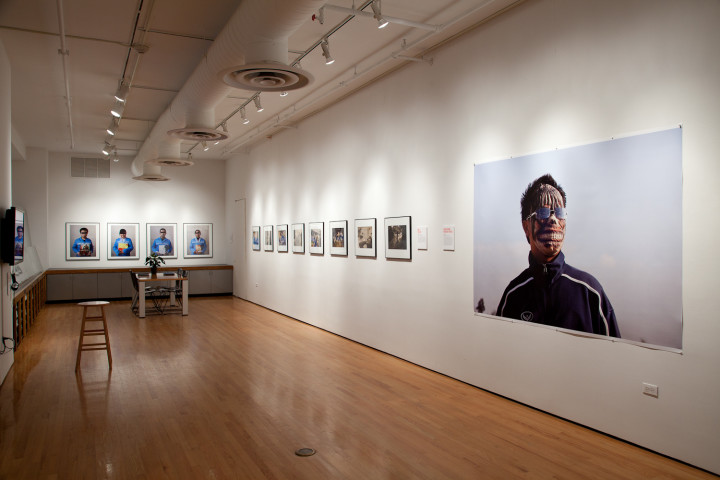
Survival Techniques: Narrative of Resistance Expanded!
MoCP, Chicago
Presentation of work by artist Uriel Orlow
Time: April 25th at 6 pm
Location: Hokin Lecture Hall, located at 623 S. Wabash Ave
Admission is free and open to the public.
After the first show in Bangkok, “Survival Techniques: Narratives of Resistance” will open in Chicago on April 12th, 2011 at the Museum of Contemporary Photography.
Special event:
Weaving together salvaged film clips, artist Uriel Orlow will present his multimedia masterpiece Aide-Mémoire at the Hokin Lecture Hall on April 25th at 6 pm.
The show, “Survival Techniques: Narratives of Resistance,” which runs in conjunction with the Museum of Contemporary Photography’s current exhibition, is part slideshow and part obscure history lesson, blending distant places and times to create a pictorial narrative merging the past, present and future.
Uriel Orlow, known for his modular multimedia installations, collects evidence from different times, locations and events. In his reconstructed pictorial landscapes, the artist references such seemingly disparate sites as Biblical Mount Ararat, a Ghost Town in Northern Armenia on the site of an earthquake and a Kurdish village in Turkey built out of the rubble of an ancient Armenian monastery.
The Exhibition:
“Survival Techniques: Narratives of Resistance,” looks at human conflict and the ways individuals and groups endure long-term hardship. The fourteen international artists in this exhibition approach contentious political issues that, although individually nuanced, present parallel fundamental challenges to the human psyche. From various reactions to situations rising out of differences in ideologies, to the impact of nationalism, ethnicity and power, the artists investigate a range of human travails—including exile, displacement and the struggle to exist in a state of flux.
Central to each artist’s exploration is an attempt to reconcile the present circumstances of a given territory with its complex and often contentious history. As the artists endeavor to bridge great spans of time, they reveal to us ways people wrestle with visions of the past and the future in order to survive. The individual artworks in the exhibition connect, echo and converse with each other, and as one moves through the various projects, specific geographies collapse into generic and unnamed worlds. As these artworks expand past local specificity they reveal universal concepts and reflect the ways our particular era exists within a fluctuating narrative of broader human history.
Curator Davide Quadrio conceived “Survival Techniques” while living in Thailand from 2008 to 2010, when he experienced firsthand the political turmoil of that country, including episodes of severe distress among his family members, neighbors and the people of Thailand as a whole. With the revolutions in the Arab world, popularly known as the Arab Spring, we have continued to see civil resistance involving various measures such as demonstrations, rallies, and marches to express dissatisfaction with existing authoritarian regimes. Yet the situations in Thailand and the Arab world—and the reactions of its people—are not unique. History bears witness to ways that individuals, groups of people, and nations survive in times of political uncertainty and social unrest.
The Artists:
Zhang Peili’s (b. 1957, China) video “Happiness” (2006) employs a subtle form of political critique. He juxtaposes appropriated film of a man speaking about political and social greatness in chopped rhetorical sentences on one screen with people applauding enthusiastically on another, alluding to the drama of political populism. The video’s structure subversively highlights the theatricality of propaganda, which has been used by top-down regimes throughout history to discourage dissent from citizens who do not agree with the principles of their government. Dual agendas also appear in the video “Them” (2006) by Artur Zmijewski (b. 1966, Poland). He invites individuals from four distinct factions within Poland—elderly Catholic women, left-wing social activists, members of the All-Polish Youth, and a Jewish youth group—to take part in a game that begins with each creating its own national flag. The edited video recounts the process as members critique and interrogate their competing ideologies and visions for their country’s fledgling democracy.
Uriel Orlow (b. 1973, Switzerland) weaves together historical documentation with his own materials in the video “Yellow Limbo” (2011), which retells the story of eight ships that were stranded for eight years on the Suez Canal following the Arab-Israeli War in 1967. The multinational crew members were forced to come together and survive communally while Cold War political allegiances dissolved, and the diverse people were united by a common struggle. Sigalit Landau (b. 1969, Israel) creates orchestrated videos where geographic spaces, and the conflicted ideologies that they contain, intersect. “Azkelon” (2011) shows young boys playing a knife game popular among Israelis and Palestinians living in Gaza and the nearby city of Ashkelon. The game, which involves the strategic drawing and redrawing of borders with the objective of overtaking another player’s space, echoes seemingly unresolvable political tensions in the territories where the players live. Knives, which are typically thought of as weapons, become tools for cooperation, sport and mutually agreed upon rules.
Both Yto Barrada (b. 1971, France; lives in Morocco) and Rainer Ganahl (b. 1961, Austria; lives in the United States) employ a high degree of irony and sarcasm in their work. Barrada’s ironic posters titled “A Modest Proposal” (2011) use photographs, illustrations and diagrams, slogans, stories, and games to comment on social and political issues in contemporary Morocco. For example, one poster satirically states “Modernize Morocco and Maximize its Resources and Efficiency” while another one asks viewers to “Pin the Moustache on the Marshall,” poking fun at the struggles the country faces in the eyes of globalization. Set in Berlin in the year 2045, Rainer Ganahl’s video “I Hate Karl Marx” (2010) presents a world in which China has risen to dominate the free market economies, and the Chinese language and culture embody the national identity of the West. A young German woman yells blame for these circumstances in Chinese to a statue of Karl Marx, as the video not only considers the ways history and national heritage take on new complexity in our global age but also taps into a xenophobia that is currently bubbling beneath the surface of Western attitudes toward China’s rising international status.
Overwhelmed by a recent revolution that shaped a nation, MRK Palash (b. 1979, Bangladesh) grew up hearing stories about his country’s violent succession from Pakistan in 1971. Like many Bangladeshi youth, Palash’s experience of this war is secondhand, yet the events led to the formation of his nation and are deeply embedded in his identity. The artist re-creates tableaux based on the stories as a way of connecting with the conflict. The photographs highlight the contrast of national heritage between the elder and the youth, and the ways one generation’s lived experience becomes legend for the next. Similarly, in his photographic series “Primitive” (2009), filmmaker Apichatpong Weerasethakul (b. 1970, Thailand) spent two months in the village of Nabua in northeast Thailand documenting and creating fictional scenarios of teenagers that are too young to have experienced the fierce oppression, fighting, and violence that lasted for two decades beginning in the 1960s, when the Thai army occupied the village in order to curb those who were accused of being communists. As the Cold War ended and the Communist Party of Thailand withered away, the government played down the violence, and quickly the public began to forget, leaving the young generation oblivious to this past.
In the deeply personal installation “Hong Rub Khaek” (2008), Navin Rawanchaikul (b. 1971, Thailand; lives in Japan) interviews Indian migrants of his parents generation who now live in his hometown of Chiang Mai, Thailand, attempting to understand their journey of coming to Thailand and making a new place and cultural home. As their stories point out, globalization has brought rapid and ongoing changes that constantly remake geographies and the people who inhabit them, often causing the concept of home to be detached from a fixed location. Rawanchaikul encouragingly describes his own complicated childhood, growing up in Thailand and coming to terms with his Indian descent, illuminating the motivation for themes addressed in his art practice.
In his series of portraits from a project titled “Blued Books” (2008–09), Li Mu (b. 1974, China) explores the ways teenagers serving sentences at the Shanghai Juvenile Reformatory live cut off from the surrounding world. As a way of interacting with these youth, Li arranged to have a library of his personal art book collection installed in a communal space at the reformatory so that inmates could read the books and meet with the artist for weekly discussions. The inmates were eager to communicate with, learn and earn trust from the outside world, and the loaned books served as their bridge. Li’s project illustrates the importance of visual communication, as art books can transcend the constraints of different languages, educational backgrounds, and age, to yield a deeper understanding of freedom through creativity.
Politically engaged with issues of human rights, photographer Raphaël Dallaporta (b. 1980, France) and journalist Ondine Millot collaborate to address the often-ignored issues of domestic slavery and human trafficking in upscale French homes. In “Domestic Slavery” (2010) Dallaporta pairs straightforward images of the facades of luxury residences with written accounts by Millot describing the experiences of individuals who were enslaved by homeowners as servants inside the buildings. The lavish exteriors conceal the stories of these individuals, who often faced extreme abuse and cruelty at the hands of their captors. “Domestic Slavery” reveals the surprising ways humans continue to be treated as objects and property in civilized countries today, while calling attention to the horror, agony and abuse that can be hidden behind an ordinary facade.
In her video “One of Us” (2010), Julika Rudelius (b. 1968, Germany, lives in the United States) explores notions of happiness using a ubiquitous ideal, the clichéd happy couple. Unlike other works in this exhibition, which deal with personal visions of political struggle, Rudelius focuses on the ways families and individuals of privilege are often insulated from large-scale persecution. This circumstance is predicated on certain middle-class luxuries, such as wealth and private property that allow couples to disconnect from the world around them. Within this context, Rudelius questions what aspects of genuine love can or cannot be captured in a moving image. The video documents men and women talking to each other about how much they mean to one another, with each couple striking various degrees of intimacy. Periodically, Rudelius finds ways to make her presence visible in the documentation, underscoring the degree to which these couples can become oblivious to everything outside of themselves.
Exploring issues of identity, culture, and sexuality, Philippe Laleu (b. 1964, France) focuses on Thailand’s transgender population for his installation “Mère nature et ses enfants, Mother Nature and her children” (2011), which combines photographs, documents, and a video interview to explore Thailand’s population of people living outside of the traditional male/female binary gender system. Despite assumptions that Thailand is accepting of variations in gender identity and sexuality, Laleu’s work alludes to the daily struggle that transgendered people face in their efforts to be true to themselves.
Conceptual artist Tintin Wulia’s (b. 1972, Indonesia) touches on many of the the overall themes of the exhibition with her installation “The Most International Artist” (2011), in which she reflects upon international borders and the obstacles they present to human movement. Wulia creates humorous videos and installations with the over 140 passports that she has obtained in her name from various countries throughout the world. She began collecting these passports after acquiring a permanent residency visa from Australia, a document that opened up access to international travel in countries where she was previously denied entry. As Wulia explains, “With my 140 passports, I am undeniably the most international artist in the universe, and the world is my playground.” Wulia’s delight in her freedom is counterbalanced by a realization of the prejudices she and many others have endured because their nationalities prevent open, global travel. Though her passports allow her to overcome certain limitations, they represent a fracturing of her identity that necessarily detaches her from her authentic national heritage.
Special Film Screening
Two films will summarize and symbolically describe the individual and social survival that humanity faces as individuals, couples and as a community. A solitude-portrait of artist and activist Ai Weiwei is described in the documentary “Before Ai Weiwei” (1994) by Daria Menozzzi. A narrative on the distortion of social behaviors in closed communities struggling to reach an understanding of what remains of inexplicable suffering is the focus of “Enemies of the People” (2010) by Thet Sambath and Rob Lemkin.
“Before Ai Weiwei” (1995) a documentary by Daria Menozzi, Premier
The intimate interview held in Beijing in 1995 by director Daria Menozzi presents an unexpected Ai Weiwei. Just back from the States, the artist explains his idea of contemporary art, his work in relationship to Beijing and China which were both to be re-discovered by the artist. Before his greatness was revealed to the world, this unique portrait of an artist struggling to position himself in an estranged world yet to become an overwhelming power of today strikes for its frankness, simplicity and fragility revealed.
The film will be presented in the exhibition in a special monitor after the first screening along with the other exhibits.
“Enemies of the People” (2010) by Thet Sambath and Rob Lemkin
The Khmer Rouge ran what is regarded as one of the twentieth century’s most brutal regimes. Yet the Killing Fields of Cambodia remain unexplained. Until now. In “Enemies of the People,” the men and women who perpetrated the massacres – from the foot-soldiers who slit throats to the party’s ideological leader, Nuon Chea aka Brother Number Two – break a 30-year silence to give testimony never before heard or seen.
Unprecedented access from top to bottom of the Khmer Rouge has been achieved through a decade of work by one of Cambodia’s best investigative journalists, Thet Sambath. Sambath is on a personal quest: he lost his own family in the Killing Fields. The film is his journey to discover not how, but why they died. In doing so, he hears and understands for the first time the real story of his country’s tragedy. After years of visits and trust-building, Sambath finally persuades Brother Number Two to admit (again, for the first time) in detail how he and Pol Pot (the two supreme powers in the Khmer Rouge state) decided to kill party members whom they considered ‘Enemies of the People.’
“Survival Techniques: Narratives of Resistance” is co-organized by MoCP Director Natasha Egan and Davide Quadrio, cofounder of Arthub Asia, a group of independent thinkers devoted to contemporary art creation in China and across Asia, with the assistance of Allison Grant, MoCP Assistant Curator. A selection of works for this exhibition comes from the FarEastFarWest collection on extended loan to the MoCP. FarEastFarWest commissions and collects challenging artworks focused on contemporary Asia and its role in the world.
